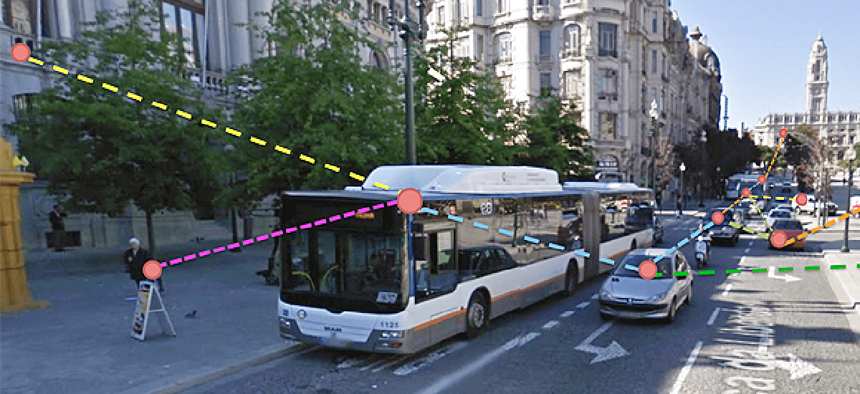A network for the Internet of (moving) Things

Veniam’s networking service not only collects data from sensors – whether stationary or deployed on fleets of vehicles – but also delivers Wi-Fi connectivity to those within range of the vehicles.
What could make more sense than to make mobile networks, and not just client devices, mobile?
That's the idea behind Veniam, a company that not only collects data from sensors – whether stationary or deployed on fleets of vehicles – but also delivers Wi-Fi connectivity to those within range of the vehicles. Initial deployments are being targeted at fleets in metropolitan areas – such as transit or garbage collection vehicles – and secure areas, such as ports.
"As a professor I've been working on connected vehicles since 2005," explained João Barros, co-founder of Portugal-based Veniam. "I was mostly intrigued by how one could use vehicles as mobile sensors to get as much data as possible about a city. That's the way I got involved in connected vehicles research – as a way to build an urban scanner."
At the same time, Barros, the former national director of the Carnegie Mellon Portugal program, and his partner, Susana Sargento, a professor at Portugal’s University of Aveiro, realized such a system would be an easier sell if it was delivering service the other way, too, by providing Wi-Fi connections to users on or within range of the vehicles.
The team also realized that, whether it's sensors or cell phones, they needed to find a middle ground between the expensive but far-reaching cellular communications and the low-cost but short-range of Wi-Fi.
The solution Veniam came up with was part hardware, part software and part process.
The hardware piece of the puzzle is called NetRider, a box that's about the size of a thick book. The boxes are not only Wi-Fi hotspots, they also include either 3G or 4G cellular interfaces, all built out of off-the-shelf components.
But the special sauce in NetRider is in the software, which scans available cellular and Wi-Fi connections and routes data in the most efficient way, ensuring that both end-user data – even streaming YouTube – and sensor data is not dropped as the vehicle moves from one network connection to another.
While NetRider supports Wi-Fi connections from devices employing all the standard IEEE protocols, Veniam engineers have also developed their own routing protocols that have enabled greater transmitting range. According to Barros, the NetRider can provide signal to devices as much as 1,000 meters away where there is a line-of-sight connection and 300 to 400 meters in typical urban environments.
The system has already been deployed in Porto, Portugal, on a fleet of more than 100 buses and other transit vehicles.
"Initially we use the cellular backhaul to learn precisely where most of the traffic is being consumed, and then we use this information to deploy access points for infrastructure communications, where you need most of the traffic to be offloaded from cellular," said Barros. "So we have a learning phase." But as Veniam learns where the dead spots are and deploys Wi-Fi access points, more and more of the data can be transmitted via low-cost Wi-Fi rather than high-cost cellular.
While the benefits of the mobile Wi-Fi are obvious for transit riders, the benefits of creating networks moving data from sensors are at least as great. "We also collect data from sensors, sensors that are on the vehicle and sensors that are outside of the vehicle but that use the vehicles as data couriers," said Barros.
Cities can deploy low-cost sensors that don't have Internet connections – sensors monitoring air quality, noise, or even how full a garbage container is – and when a NetRider-equipped vehicle goes by, the data will be picked up. "When a public bus, taxi or garbage collection truck comes by, it syncs with the sensor, it gets the data, stores the data and whenever the vehicle is within range of an access point it sends the data to the cloud," said Barros.
Veniam's mobile networks offer both end-to-end encryption and authentication. Authentication is generally not required on public buses. "Our customers opted not to have logins," said Barros. "So it works without authentication, and we are not tracking any user behavior. In other venues, such as ports, authentication is very important, so there we offer virtual private networks for each operator and authentication."
According to Barros, the NetRider technology is especially appropriate for ports, container terminals and even military bases, where cellular doesn't work well because large metal containers make the signal propagation less efficient. "Normal Wi-Fi has a range that is too small for such spaces," said Barros.
"Our technology allows vehicles to communicate over ranges that are 10 times larger than traditional Wi-Fi. We also were able to establish connections in 2 milliseconds, as opposed to a few seconds that normal Wi-Fi requires."





